If tomorrow a three-day blackout hit your area, would you know how many solar panels and what generator you need to power up your fridge until power is restored?
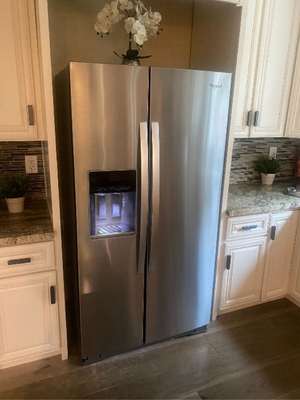
Today I hope to show you exactly what kind of solar setup you need to keep your food from spoiling during a blackout.
I’ll also show you exactly what it would take to run this rather large fridge for a three-day blackout.
The first step is to figure out how much electricity your fridge uses. The power your fridge uses is measured in watts. But to calculate the power consumption of any appliance, including a fridge, you have to multiply its wattage by the number of hours it is being used (operational hours).
Related: 7 Terrifying Realities Of Long-Term Blackouts (That You’ve Probably Never Considered)
They say a fridge needs to run 24/7, but that is not an accurate statement, because it cycles on and off. The U.S Department of Energy estimates that a fridge runs for about eight hours each day.
The wattage is not usually displayed on an appliance, but what you need to calculate it is.
The easiest way to do that is to look for a sticker inside your fridge that shows how many amps and volts your unit uses when running.
The formula is Amps * Volts = Watts.
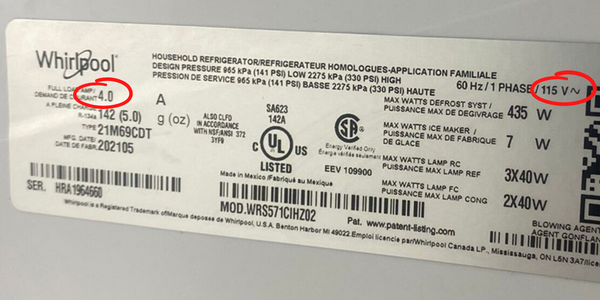
In this case, we have 4 amps and 115 volts.
So the fridge uses 4 * 115 = 460 watts per operational hour. There is one more thing to consider: When plugging in any appliance, it will use more power for a few seconds and then go back to its normal power usage rate.
So whatever you are using to power the fridge needs to be able to deal with this surge. It is usually a 1.5x multiple of its running watts, so in this case, 460 * 1.5 = 690W. Your generator’s continuous output (and not the battery capacity) needs to be higher than 690 watts or your fridge won’t start.
A generator always has two things listed: this continuous output in watts and battery capacity in watts-hours. Both are important.
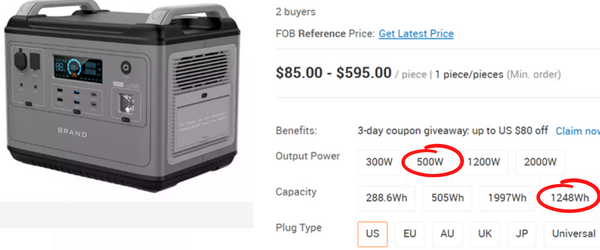
In the most simplistic view, a solar generator is basically a battery with some photovoltaic (PV) panels attached to collect the free energy provided by the sun’s rays.
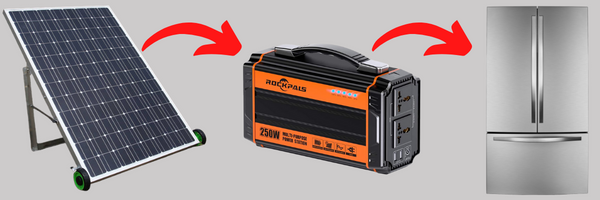
But why not connect your fridge directly to solar panels? The reason is that solar panels don’t produce energy at night and not even for most of the day. What you can expect, on average, is for solar panels to produce energy for about five hours each day, and you need to store that energy in a battery bank for your fridge to draw on whenever it needs it.
Now the question you need to ask yourself is if your battery has a large enough capacity to run the fridge for the rest of the day when the solar panels are not charging it (19 hours a day) and if your solar panels can put enough power back into the battery so that it keeps a fridge (or whatever else you need) running for the entire blackout.
⇒ 3 Naive Mistakes You’re Making During A Blackout That Put You And Your Family At Risk
Keep in mind that solar panels are not 100% efficient. That means they will never capture all the energy from the sun. A 65% efficiency is what you can expect, so a 500-watt solar panel will not give you back 500 watts but only 325 watts per hour.
I made a simple table to illustrate this more clearly. In the first column, you have the hours. 10 p.m. is when the blackout started and you had to switch to solar to run the fridge. Column 2 is how much power your fridge uses every hour. Column 3 is the solar battery capacity you have available to run it; we’ll put that at 4000 WH to begin with. And columns 4, 5, and 6 are different types of solar panels that recharge that battery.
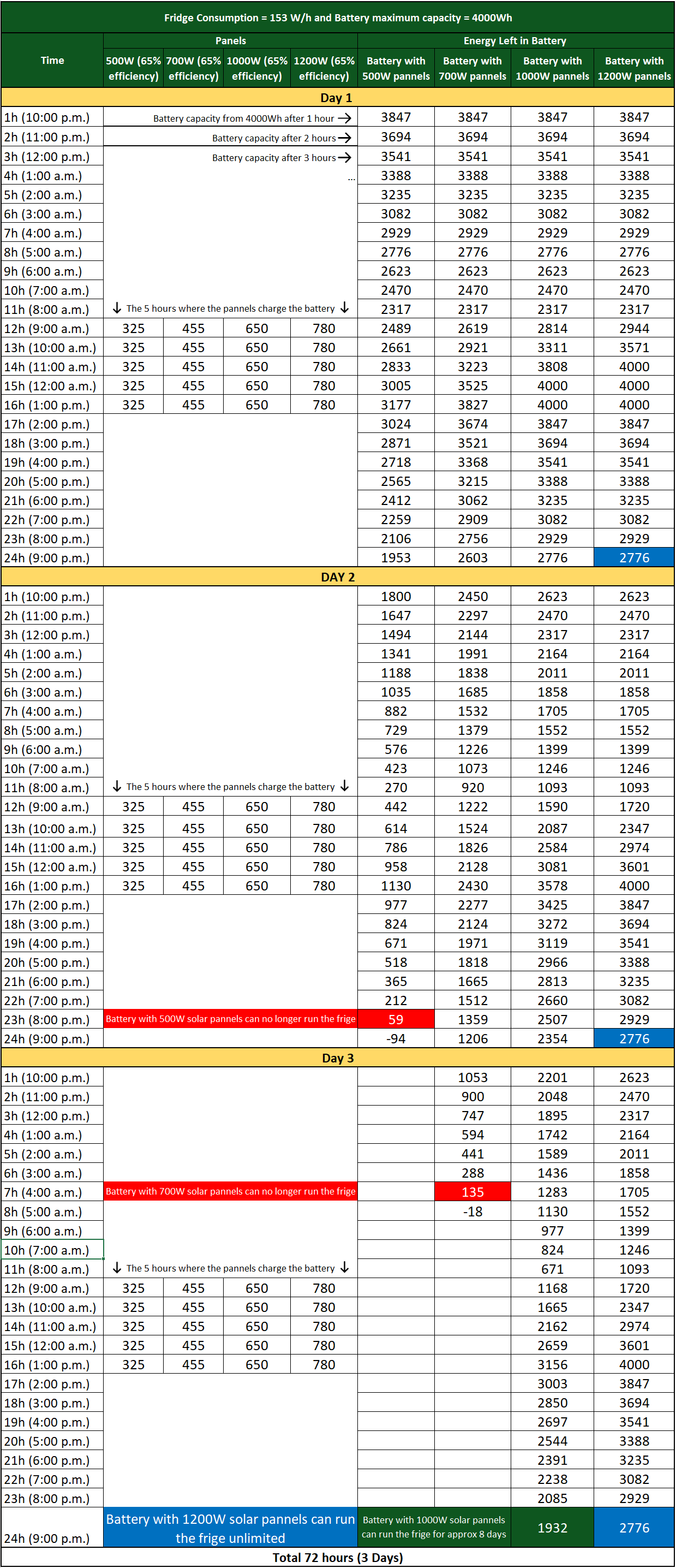 Let’s see how each of these solar panels does in our three-day blackout scenario.
Let’s see how each of these solar panels does in our three-day blackout scenario.
First the 500-watt ones: The fridge has drained the battery down to 320 WH when the solar panels kick in and starts recharging. In five hours, they put back 1625 WH in the battery before the fridge starts discharging again. As you can see, at 9 p.m. the energy level turns negative. That means your fridge stops working until the next solar charging hours. That is 13 hours without power, so your food will most likely spoil.
⇒ What To Do With All Your Frozen Food Once The Power Goes Out
Next we have the 700-watt: The same story, only they last a bit longer. They give in by 5 a.m. on the third day. Still, with the panels only a few hours away from charging, in this scenario, your food would have probably stayed good, but they will spoil on day 3.
The 1000-watt will keep the fridge going for the entire three days, and they never run the risk of not charging the battery. If you keep on with the calculations, you will find that they will power your fridge for approximately eight days, so will cover most blackouts.
But the 1200-watt panels will last virtually forever as they put in more power in those five hours than the fridge uses all day and night. This means that this system will not only outlast any blackout but even an EMP.
Now, if your battery was bigger, say 8000 WH capacity, you could go with smaller panels to outlast a three-day blackout for example. There is always a balance to be found, and hopefully, from now on, you’ll know exactly what kind of system you need to run your own fridge using solar energy during a blackout.
By the way, if you want your solar generator to run more things, like a laptop, AC, or a heater, you can also calculate their power consumption and add them to this kind of spreadsheet.
My calculations are pretty simple as I didn’t want to overcomplicate this article. But there are other things you need to consider, like the efficiency of your battery, how many times a day you open your fridge, how many defrost cycles your fridge needs over time, etc.
Running your fridge during a blackout is just one of the things you need to survive in a world without electricity. But I would like to show you 75 more projects, including how to build your own backyard solar system, harvest and store water, secure your property against looters, build your mini root cellar, and many others inside No Grid Survival Projects. Click on the link to watch the video.

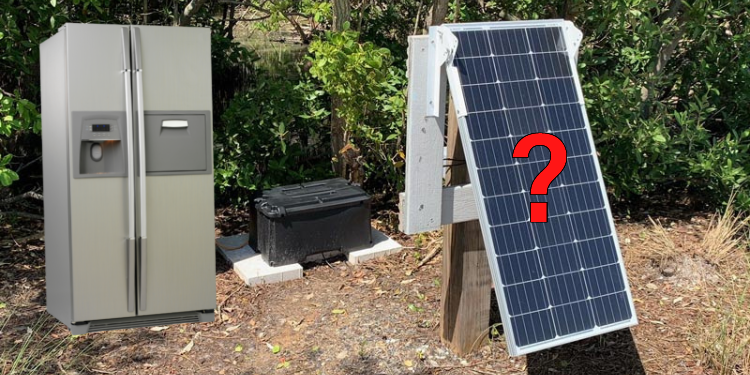













You would be better off using it on a freezer….. and not something like a fridge…. (Colder and you won’t be running it as much (as the compressor won’t be going on and off like a fridge does)
Glue 4″ Styrofoam panels to all sides of the fridge.
That will keep it from running nearly as much.
If your fridge is blocked in and can’t get air you’re going to burn out your condenser!
csquirrel. Before you glue your styro to your fridge you need to do some checks. Look behind your fridge & see if there are a bunch of small tubing going up & down. Then put your hand on the side of your fridge when it is running. Is it warm? The majority of both fridges & freezers have the condenser coils attached to the sides of the unit. Putting insulation over that is no way to reject the heat.
Many systems use the outer case for radiating off the heat being removed from inside. Make very sure yours is not one of these or you will ruin it by adding insulation to the outside.
Where did you get your 153 w/ hrs for the fridge consumption on the table?
What would a 8000WH cost to set up ?
dollar per watt on panels….
batteries are where you end up spending a fortune.
Proper long lasting batteries are a high priority like the Wall battery or the lithium 12 volt ‘Battle Born’ batteries with go for about $1000 for a 100 AH battery which can be completely discharged and recharged about 1000 times
How often do you open your freezer. I have two refers and one (so far) freeze. if you don’t open the freeze but maybe once a week, and only in the daytime, ie when the solar is charging, it works. right now I can sell to the grid, ie I have excess capacity. So i figure, I’m good. After the grid, may turn off one fridge, haven’t decided. Use excess capacity for other appliances, only in the AM when I’m filling batteries. Depending on time of year, mine are full by noon.
Hybrid setups are the most pricy ……
you can end up spending 80 grand easy to do a Hybrid setup with batteries and connections to the grid
Sadly this isn’t possible in Australia.
Australia’s network is old and problematic, and largely government owned. So they’ve gone with a “on, or off” approach. If you are on the grid you can sell excess power to the grid, but you cannot store it in batteries.
If you are off, you are completely off.
This could have changed in some parts, but was generally the rule, and is definitely the rule in Western Australia. So you either pony up for the batteries, or run as a feed to grid system. The issue is when the grid goes down so does the feed to grid systems. Bollocks!
mine was $30,000 which is an Outback radian 8,000 watts surge to 16,000 (2) outback MPPT charge controllers 16 MK battery 100 amp hour gell cells
which is not enough so I’ll be getting more soon.
and 4,000 watts of solar panels I can run indefinetly
1freezer 1 fridg all the house lights (LED) a Gas hot water heater 1 large TV
1 automation system a camera system and a couple window units. the central AC and electric stove are not on the system
Batteries are rated in amper hours (ah) so why did you do all you calculations in watt hours without an explanation or show a conversion method to be able to calculate battery size?
Watt Hours = Amp Hours x Volts
Amp Hours = Watt Hours / Volts
(At least that’s what I seem to remember from 12th grade electronics class back in 1977)
You didn’t say anything about refrigerators don’t run on DC; they run on AC which requires an inverter. Inverters are not 100% efficient and use a small amount of power even when not powering your fridge.
You should NEVER discharge a battery below a certain amount, I think it’s 25%, or the battery may be damaged.
It should also be said that most solar companys will install a grid tied system that will stop working if the grid goes down so what ever sustem you go for should be OFF GRID.
Evidence abounds about the need for an inverter for fridges in a wheatbelt town where the local power has been on/off for weeks. Plenty of dead fridges, as people hooked up to solar panels and generators without making sure the power was the right type. Ugh.
It’s 50 percent
Regular solar batteries can’t be discharged , I think below 40% , But the new Lithium bateries can go lower and the Battle Born Lithium can go to 0 and back to 100% a 1000 times But they are $1000 a battery , Still well worth it – They cost 3 times the regular solar batteries BUT last 5+ times longer
they have a lower rate they can discharge too…. but you won’t see 5x life of the battery. its more of 2x…. ish
you are so right as you look at your Neiborhood all those systems will be useless in a grid down systems. you MUST have a battery-based system (Outback radians for one ) the deka solar batteries mentioned above can withstand a complete discharge and not be damaged as they called acid starved deep cycle battery
it is still not recommended to NOT go below 50% charge.
as you lessen the life.
So does this calculation also work if you wanted to power AC/Furnace? I live in very hot area of California and it gets up to 110+. Not having a way to cool down if I were to bug in without AC would be simply miserable. Forested areas are about an hour away and they to are very hot during the summers.
Hi Hersch. Yes, it will work. But you have to know all your parameters as mentioned above. Note John’s message above too. You’ll need to convert battery power, (DC) to AC. So an “Inverter” is needed too. And while one guy commented on spending 80K, that’s true if you want a whole backyard of solar panels. But for a bug out type thingy, Amazon, Harbor Freight, and a host of other type stores can supply the bulk of what you’ll need. Plus, there are a ton of great vids on YouTube explaining solar energy too. Great resource! Hope this helps. -Mike
Unfortunately, most residential a/c systems are 220V and while this isn’t an issue for the inverter, it is an issue for system capacity. It’s not the voltage itself that’s a problem, it’s how much amperage they draw and for how long. Much more amperage required and a much longer duty cycle. And electric heat is even worse. Meaning it draws more amperage than an a/c unit will. For example the backup heat on most geothermal systems, which is a large electric heater, has TWO 60 amp circuit breakers. Those units have such high amp circuitry because they’re overcoming other system ineffientcies, but most residential electric heating systems have 30 or 40 amp breakers. And no, breaker size is not a rock solid indicator of usage by any means, but it puts things in perspective. The fridge mentioned above would run just fine on a 10 amp breaker, even factoring in the start surge. You will need a large capacity system to run residential a/c. Having said that however, you could put a small a/c unit in your bedroom, home layout permitting, on a timer so you could be able to sleep at night. A SMALL window a/c unit will use just as much as, or slightly more than that full-sized fridge mentioned above. But now we’ve just doubled the size of your power requirements, assuming you want the fridge to stay running. I love my a/c and don’t breathe quite as well when the humidity is high but likely i won’t have a/c when SHTF.
Look up swamp coolers.
Gave thumbs down by mistake. Sorry.
It won’t let me undo it either.
In areas with LOW Humidity swamp cooler are pretty useful and fairly low energy users.
Problem is generally where swamp coolers work well are pretty arid desert like and getting water to “waste” in this manner might become difficult.
In hot damp areas not useful. If you get hot steamy days adding more moisture to the situation will not work. Indeed, mold issues are a real issue in hot steamy environments, requiring excellent ventilation. Some bathrooms with showers have a real need for a bathroom fan-vent. Same reason.
I would love to see an article on keeping cool in warm summers, particularly in urban areas and if bunking in to an apartment/rental.
There’s a lot of focus on when it’s cold, and cold kills, but so too does excessive heat without relief. We need to cool our body temperatures down after day upon day of 35+ weather!
Basements were popular with my Grandparents for summer sleeping.
I’ve used good quality hammocks in hot and humid areas to get sleep. They work nicely indoors once you get used to them. With an insulated pad (think thin mattress) they work well even in very cold weather.
Shade and breeze even if it’s a solar powered fan.
For the deeper pockets: (Snip) A 6000 BTU window AC needs at least a 600W generator. At standard efficiency, the 600W can provide adequate cooling to a small space. Starting up a 6000 BTU window AC will require more wattage than 600.
So, a given the old rule of thumb that every time electricity changes you lose 10% From the DC solar panel to the batteries, to the inverter to the ac unit. So, I’d go for a 1KW solar array. I’ll let you figure out the batteries needed for overnight use plus a bit for cloudy days. Lead Acid batteries should never be drawn down more than 40% of their capacity. Lithium Ion can be fully drained without damage.
Drink lots of water, if obese lose weight as they suffer badly from heat issues.
Humans survived well enough before electricity and AC was invented.
Might plan on getting a Ductless Mini Split heat pump installed before and keep it for the SHTF , as long as it is not an EMP situation — the Mini splits can go 24,00 BTU on 120 Volt house hold plug and are 18 -20 seer rating so electricity is minimal
you can’t run an electric furnace as some reach an incredible 30,000 watts. if its gas then the only thing involved is the house fan 2to 5 hundred watts. also, the central air is out you need to secure a few window units.
so no electric hot water heaters, no electric stoves, no electric furnaces, no central AC compressors, unless you have the $80,000 system mentioned above. and the batteries will be almost half the cost of your system.
I live about 40 miles N of Houston and have a 9.2kw rated systems which actually pruduces 7.8 KW/hr at peak sunshine on a VERY clear day. 3 Tesla Powerwall batteries power my entire house in the middle of the summer, air conditioning, hot water heater, stove (all electric house with 2 x 6 walls and Low E glass). I am tied to the grid and haven’t paid an electric bill since last March. When the grid goes down, you never notice as the brains control where the juice comes from and it is a flawless change over, no flickers no nothing. That has happened several times this year and we did not know until the neighbors said something. I set my batteries to a max discharge down to 40% and then the system switches to grid power. Batteries are expensive, our three cost $21,000 and then the price went up more last summer. We pay more attention to our power usage now that we make most of our own and are much more conscious of wasted energy than we used to be. Our panels face SW so real power production does not start until about 11:00am and ends at about 5:30pm during the summer (trees get in the way at that point)..
Are there any solar panels made in the USA? And who are the companies that manufacture them?
Thank you
yea, there are, just do a search for USA made solar
Typical house needs about 25KW of available power.
You need double that to run the house and charge the battery banks. Maybe even triple.
One site says it take 125 solar panels to make 50kW of power.
Figure on 200 of them to be safe.
That takes a LOT of space too.
A big part of living on solar is working out what uses power, and when to run those things.
Insulate the fridges and freezers further, only open them at certain times and leave them shut when the sun isn’t shining.
Turn off any hot water or pool heaters or other gadgets that aren’t really necessary, and consider swapping low efficiency models for higher quality ones (like heat exchange pumps instead of insulated hot water tanks with an electric element).
Install kill switches that turn off all your ‘sleeping’ appliances – so you can switch one switch and all the tvs, consoles, computers, everything on a wide range of designated power switch circuits is off (or walk around and turn them off properly frequently).
Move to battery charged devices such as laptops and ipads. Charge these during daylight hours.
The biggest power sucks in a house is generally fridge/freezer, heating/cooling, hot water and entertainment devices/screens.
Plenty of houses in Australia with only a dozen or so panels on their roof feeding excess into the grid during the day, using the grid at night. Many of these are occupied by people who are ruthlessly efficient about their power useage and getting a cheque back from the power company for what they sell to it, ie they use less from the grid than they send in (no batteries).
Fridges sorta…. and Freezers not so much, The initial start up is typically a spike but once its running . They don’t typically use much.
If anyone is serious on this site… which by the mis information shared…. i doubt it.
However get yourself a killiwatt reader. (it allows you to plug in your item (aka fridge and then into the wall) it will give you a data read out of the power it used during that time frame.
once again, a system with no battery’s, shuts down making is useless for a grid down scenario.
All good ideas if you happen to live close to the equator and have plenty of room to set up panels away from your house. If you are thinking of putting them on your house, check with your insurance company to make sure you will still be covered if you have a fire. Fire departments, generally won’t fight a fire in the best way to save the structure if it is covered in panels.
Or you again would be wrong….
You can run solar in Wisconsin….. yet you need to be able to tilt the panels…. roof mounts are stupid unless you have it on a automated setup for tracking the sun. You can vary your pannels to get what you need…… your harbor freight amazon hodge podge kits are great…. if you have a clue of what you’re doing…. Which nobody here seems to even have that knowledge to do.
I’m sure you can run it anywhere, as long as your willing to wait for a sunny day.
that’s why you have batteries….
solar works fine in Canada you just have to add the loss percentages to your calculations.
Thanks for this article – a good primer for getting a handle on the types of calculations. We can each develop a spreadsheet similar to the one included but need to allow for all appliances that we MUST have working. For example, it may be more cost-effective to ditch the second fridge and use its contents immediately (freeze the excess meals ?) rather than expand your solar array (which you may need to keep hidden anyway). I live in sub-tropical Queensland and only run aircon a couple of times a year when it’s really too steamy to sleep – open windows and ceiling fans do the job otherwise. Insulation &/or whirlybirds on the roof can do a lot of temperature control too, and are much cheaper than adding solar just for aircon where not really necessary. Basically I’m saying limit your consumption to necessities to reduce the amount of solar needed to keep you going – and harden the F*$k up.
Liked many of the above comments – particularly the need for an adequate inverter. It must meet the surge needs of a starting appliance – even while other appliances are drawing power – and of course the battery/s must be up to feeding it.
Not mentioned is cooking – An air fryer is probably the most power-efficient electrical solution? Roughly 1000 watts for a family meal of ‘meat & 3 vegs’. Governments here are trying to wean users off gas (environmental and health/explosion risks) and most of the rural areas don’t have a connection anyway so all household power is from moving electrons.
In summary – treasure this article and start by determining exactly what you will NEED to rely on in SHTF then do your calculations as modelled. You can start living ‘as if’ S has already HTF, and save power bills in the meanwhile.
PS: Don’t ignore that wind and/or running water can replace solar as your source of energy where conditions are right and the same calculations apply.
Stay safe
Well let’s put it this way … you need to learn to use less power
The rich are building awesome off grid homes in Califa these days using large solar arrays and Tesla battery packs, but we are not the rich. If you are planning for a week w/o power solar is the wrong answer, you need a generator sized for your needs. If you are prepping for SHTF you won’t need a fridge or freezer because there won’t be anything to put in them. I farted around with solar and finally learned the best way to go is a solar generator, buy a system that includes charge controller, inverter, solar panels, and a lithium battery. You can get a decent one for 1500.00, spend more you get more. Plan on powering LED lights, small fans, maybe a RV type fridge. No matter what you do, you have to have high end lithium batteries, any other battery you are likely to kill the first week.
Prepping ain’t about keeping your beer cold and sleeping with the AC down to 68. We lived w/o AC in my younger days, one of my favorite memories is laying an old mattress out under the cottonwood in the backyard, hiding from the skeeters under a sheet, how good it felt 5 AM summer mornings when it cooled off.
I believe your 65% efficiency is a pipe dream. 20 to 25% is pushing the high side of photovoltaic products currently available making system calculation very different?
In direct sunlight its pretty close to 100 percent….. you do have line loss… .and intervertor loss …. but its not that bad.
I don’t understand ether, yes solar photovoltaic efficiency is indeed around 20%for the good panels. All battery’s that are not lithium will die is Bull#@#t see post above my Deka Solars lasted 10 years.
here’s where the losses are if you buy a 1,000-watt solar panel you will get 1,000 watts out. Next inline part is the charge controller 20% loss unless it is a MPPT next is inverter 10% loss for the good ones. If your using lead acid batteries, it’s a 25%loss for charging. See above post
If one is so stupid as to not recognize the difference between AC and DC or 12 volts and 110, they need to stay away from wires!
Every once in a while, the power company offers to mount panels with inverters. I’ve been putting it off because we need to beef up the roof to make it fire resistant (from fire bombs). But, power went down for 5 hours the other day. Town is at the end of the line and well away from the main drag. People complained, but I said at least it happened now, with cool weather (about 80F) and not in July with 100+ degrees and high humidity. Arizona is going solar, thanks the repubs. Gotta get on the ball, again, and get things finished. niio
Yeah… you wont have power when the grid goes down…
NOT A CHANCE of 100% conversion to usable energy even with limited line loss….. I actually posted a link to a June ’22 Forbes article, but it was stripped out of the post.
The solar panels all sound great during the day for power. Most people can’t afford the batteries to make up enough storage backup to power an average home at night.
Batteries have a potential to explode. Especial that type of batteries used in EV’s lately. Seems those Li batteries should not get wet, or they short out. Cause a home to catch on fire. Any Electrical Engineers out there that can verify the safety of batteries used for solar systems?
First, CHEST FREEZERS are more efficient than uprights, depending on age they may be substantially better, not dumping all the air every time you open the door.
2nd, I keep several gallons of ice in the freezer. In the event of short term outages i can transfer them to the fridge. I also monitor the temp in the fridge (and freezer) with an appropriate thermometer with a sensor on thin wire that doesn’t interrupt the door seal over much.
3d, I transfer any frozen stuff to the chest freezer at the get-go and anything else that i can and have no immediate plans for.
I might also mention that the cooler the outside air is around either refrigerator or freezer, the more efficient the system is in providing the desired temperature inside those objects…
Anyone one posting here from Western Washington? I’m 100% off the grid have to build a fire for heat (I use a 1937 wood burning stove?oven). pump water from the river or wait for the rain to fill 2100 gal tanks. Anyhow my Husband recently passed. He set up a solar system 10 panels . before he passed he bought 4 more panels (not hooked up) bought a second inverter MAGNA SINE Magnum.. We have a 6 battery Tesla bank. Using the solar for 9 years but the Tesla is new. Anyhow I should have paid more attention. I know really nothing . If anyone can tell me spare parts I should get before the SHTF I did find his book “Photvoltaics design and instsallstion Manual” Sill Hard for me to understand.
Anyhow can anyone let me items to have on hand, where to get them, and a youtube or like where I can understand how it work before I have a problem. Just point me somewhere please. I’m not stupid just out of my league.
Thanks
My experience. Almost new Samsung fridge died. I live on grid in a very rural area, but am also completely set up for off grid.
Then my expensive DC freezer died. That’s a lot of money wasted.
After much research I went with multiple camping fridge freezers, each one having a 100 w solar system. My smallest is 21 qts, my largest..60qts. I have 4 altogether. If one goes out, I still have others to use. Plus I made several large Zeer fridges for veggies and fruits. None of these have broken or needed repairs, going on 3 years now.
All mine are Iceco brand.
Evap cooler: I gutted two of the largest Champion brand coolers. I put in a small pond pump and put a Lasko Weather Shield 60w fan in front of the hole. Runs off a 100w solar system. Uses a lot less water too. I live in the desert and it never gets less than 75 in my cabin.
The most peculiar thing I ever bought was an energy storage battery. I once believed it to be wholly pointless. And for a very long time I refused to obtain one even after my girlfriend’s parents suggested we have one. But I later came to the conclusion that they had more knowledge than we had and would not give us stupid advice. At this website site site , my father-in-law and I decided on a battery. We were delighted with it.
How well does solar work in the Northwest like Western Washington where we get weeks of cloud cover in the winter?